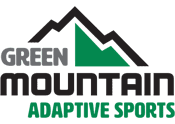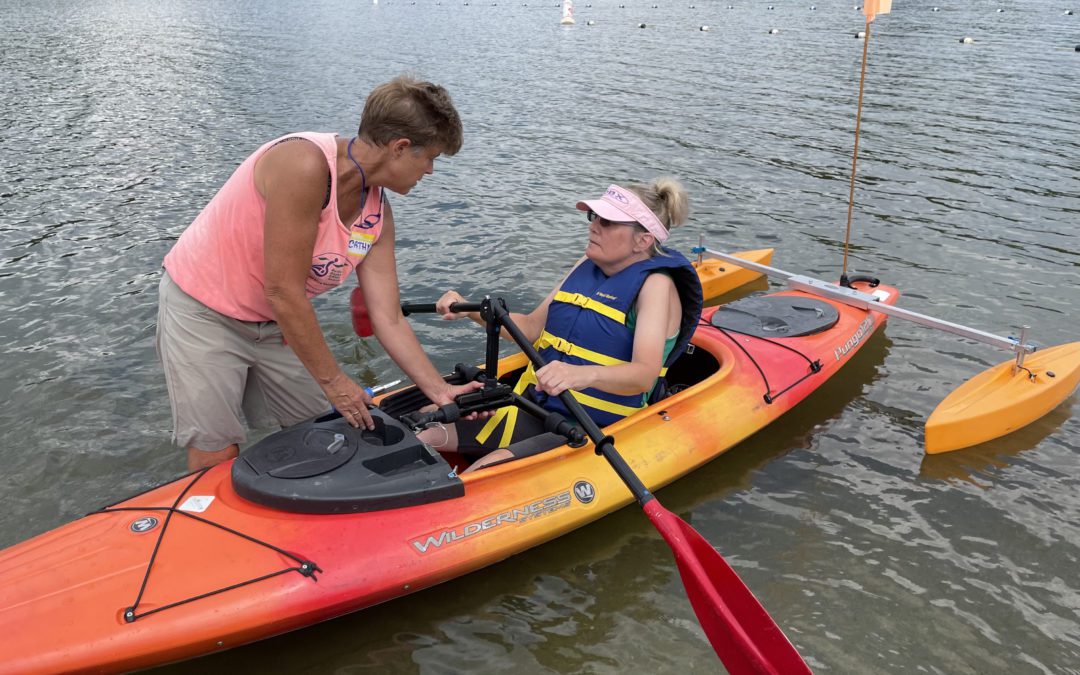Cathy Webster provides people who struggle with independent mobility with a life-changing opportunity: to get out on the water and move along under their own power through adaptive kayaking.
This summer, Green Mountain Adaptive Sports partnered with Cathy to provide our students with access to the Adaptive Kayaking program that she runs for NDAA (Northeast Disabled Athletic Association). We were extremely pleased to have twelve young athletes sign up, and begin their relationship with the world of kayaking, and all that one can experience paddling across a beautiful body of water in the Green Mountains. In the summer of 2021, Cathy launched her 100th participant in the program, and has had 275 individual launches this season to date.
We sat down with Cathy to discuss her program, her dreams, struggles, and more.
1- Tell us a little about yourself.
Growing up in Quebec, Canada on a dairy farm, I was very active in sports, mostly skiing, running, cycling, and being with animals. After graduating as a PT from UCONN and having worked in many areas of the profession, my focus has always been to think out of the box and to help my clients in creative ways. I currently work at The RehabGYM in Colchester, and live in South Hero with my partner, 2 adult kids in college, 3 dogs and 2 cats.
2- How did you get involved in adaptive sports?
One of my first clients when I moved to Vermont was a newly injured woman who became quadriplegic in a car crash. After years of traditional PT, she asked me if I thought she’d ever be able to kayak. That’s all I needed to get the ball rolling, wheels spinning, and…people paddling. I brought my kayak to work with me, got her into the kayak and began to figure out what might be needed for independent paddling. How cool it would be to help those with impaired mobility, get out on the water moving along using their own available strength.
3- Tell us a little about the kayaking program over the years.
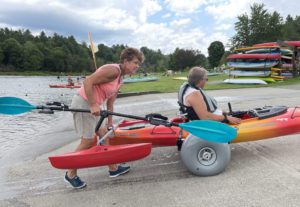 Many of the adaptive components were already available commercially- outriggers, high back seats, hand and wrist supports and paddle assists. I rushed to get everything together by the end of the summer and the program launched in 2015 with one person. Through equipment tweaks and extending my own knowledge and experience this summer, we launched our 100th participant in the program, and have had 275 individual launches this season to date.
Many of the adaptive components were already available commercially- outriggers, high back seats, hand and wrist supports and paddle assists. I rushed to get everything together by the end of the summer and the program launched in 2015 with one person. Through equipment tweaks and extending my own knowledge and experience this summer, we launched our 100th participant in the program, and have had 275 individual launches this season to date.
People with all different mobility challenges participate, many of who are severely impaired. I don’t like to put people into categories, because each person is so individual. Some of the types of disabilities that people who have participated have include stroke, muscular dystrophy, spinal cord injury, cerebral palsy, cancer, amputations, traumatic brain injury, Parkinson’s disease, and autism, as well as many others.
Our primary venue is Waterbury Center State Park. Other locations include South Hero, Green River Reservoir, Metcalf Pond, and Elmore Lake. We will go anywhere there is a flat parking lot with a gradual approach to the water, which is necessary for the equipment used.
Volunteers are an integral part of the program. To run smoothly I need between 3-5 volunteers per outing and I have been lucky to find those people: UVM DPT students, GMAS volunteers, friends, family of participants and local therapists. Volunteers are trained during the preseason, and as others come along during the season, they observe and as comfort level improves with equipment, they can take a more hands-on role. The single most important piece to the “adventure” is proper seating. If a paddler has the appropriate support in the right places, it allows them to use the strength they have available to their best ability. As a PT that’s my job, everyone else helps with putting adaptive equipment on the kayaks, helping with life jackets, moving boats, joining as a companion paddler on the water, or taking pictures and encouraging from the shoreline.
4. How is the program funded, and what does this require from you?
 Working with a small all-volunteer nonprofit necessitates obtaining donations and grants to fund equipment and travel. We started with two donated kayaks. Over the years, we’ve been able to obtain four more kayaks, which are all fully adapted, and a trailer to haul and store them along with much of the gear. Individual participants have received grants from the Kelly Brush Foundation to purchase their own kayaks. We received a Dana & Christopher Reeve Foundation Direct effect quality of life grant in 2019, and this year we have received support from The Neilson Foundation, The Veterans Association, and The National Life Foundation. Vermont Parks Forever has been extremely supportive over the years, providing park passes for our participants and volunteers. The program is also sustained by individual donations. Much of my off season is spent searching for, writing, and editing grants, as well as looking for used kayaks to be used in the program.
Working with a small all-volunteer nonprofit necessitates obtaining donations and grants to fund equipment and travel. We started with two donated kayaks. Over the years, we’ve been able to obtain four more kayaks, which are all fully adapted, and a trailer to haul and store them along with much of the gear. Individual participants have received grants from the Kelly Brush Foundation to purchase their own kayaks. We received a Dana & Christopher Reeve Foundation Direct effect quality of life grant in 2019, and this year we have received support from The Neilson Foundation, The Veterans Association, and The National Life Foundation. Vermont Parks Forever has been extremely supportive over the years, providing park passes for our participants and volunteers. The program is also sustained by individual donations. Much of my off season is spent searching for, writing, and editing grants, as well as looking for used kayaks to be used in the program.
We have seen both quantitive and anecdotal growth of the participants. From this season alone, many kayakers have shown improvements in speed of paddling, efficiency of their stroke and duration in kayaks. Ten participants currently have their own adapted kayaks and come frequently to paddle for many hours at a time, or are independently kayaking with friends and family.
5- Can you tell us about your consulting work with other adaptive kayaking programs?
 I have collaborated and assisted many individuals around the world with questions pertaining to adaptive kayak setups. There is a lot of thought and planning that goes into each individual’s unique adaption. There are often mobility and strength limitations as well as figuring out the best way to transfer in and out of the kayak as well as how to best transport them to the water. I have an eager group in Northern New York who I work with each year, launching on waters near Saratoga. This year I connected with The Adaptive Sports Foundation In Quebec. They hope to add kayaking to their summer activities. We have planned an outing for this fall to assess participants’ interests and equipment needs. I am open to, always looking for, and thinking of new groups to reach out to.
I have collaborated and assisted many individuals around the world with questions pertaining to adaptive kayak setups. There is a lot of thought and planning that goes into each individual’s unique adaption. There are often mobility and strength limitations as well as figuring out the best way to transfer in and out of the kayak as well as how to best transport them to the water. I have an eager group in Northern New York who I work with each year, launching on waters near Saratoga. This year I connected with The Adaptive Sports Foundation In Quebec. They hope to add kayaking to their summer activities. We have planned an outing for this fall to assess participants’ interests and equipment needs. I am open to, always looking for, and thinking of new groups to reach out to.
6- GMAS became a partner this year. Can you tell us a little about that?
Partnering with GMAS has helped open up the kayaking experience to participants in the area who were not aware of this opportunity as well as providing volunteers. Each participant is paired with a volunteer kayaker. Many times this can be a family member, other times participants come alone. The GMAS folks have local PT’s and OT’s who have been really helpful as volunteers. They made the program run smoothly due to their familiarity and guidance of the students that participated. We worked with a number of autistic teens this summer. Their love of the sport and the progress they made has been incredible to witness.
7- What is your biggest challenge with the program?
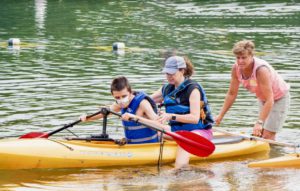 My biggest challenge with the program is managing its growth. This year, especially, things have really taken off. When I’m not at Waterbury on Tuesdays and Thursdays, I am consulting with new referrals, performing assessments on land or juggling the schedule. I also have some folks who aren’t able to make it to Waterbury due to transportation or logistical reasons, so I do many individual or small group outings at locations more convenient to them. A few more hours in each day would be great to have!
My biggest challenge with the program is managing its growth. This year, especially, things have really taken off. When I’m not at Waterbury on Tuesdays and Thursdays, I am consulting with new referrals, performing assessments on land or juggling the schedule. I also have some folks who aren’t able to make it to Waterbury due to transportation or logistical reasons, so I do many individual or small group outings at locations more convenient to them. A few more hours in each day would be great to have!
8- Is there a piece of equipment you really wish you had?
With all pieces in working order on each kayak, my adaptive fleet is a good size- it would be difficult to have more adaptive paddlers on the water at once and be able to keep up with each individual’s needs, which I think is very important. I’m always looking for kayaks to be used by my volunteers, and am lucky to have some loaners this season. Similar to the kayaks I use with participants, I look for stable, easy to maneuver kayaks with large cockpits to allow volunteers to be most useful as a companion paddlers. Probably the biggest piece of equipment that I am in need of is a truck to haul the kayaks around with. Each week puts 300-500 miles on my partner’s truck which is nearing the end of its life.
9- Can you give us some “aha” moments you have experienced over the years?
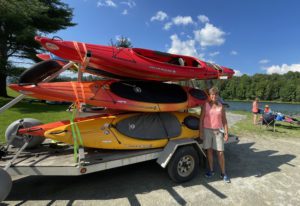 The single best addition to our mix of adaptions other than the necessary outriggers and high back seats has been the supported, angled paddle. Prior to this being available, folks with weak upper trunk or shoulders would constantly need to be repositioned and aligned to be most efficient. The outings early on were an “experience” on the water with lots of stopping to alter hand placement or sitting position. The angled paddle enables the paddler to keep their arm height low allowing for a more stable sitting position. The outings suddenly became more of an “adventure,” being able to go further with less fiddling with equipment. This allows the opportunity to enjoy time on the water, watching birds, exploring the shoreline, enjoying the activity with friends and family. Each person’s success on the water gives me goose bumps. Providing the opportunity for people who struggle with independent mobility to move across the water under their own power is life-changing.
The single best addition to our mix of adaptions other than the necessary outriggers and high back seats has been the supported, angled paddle. Prior to this being available, folks with weak upper trunk or shoulders would constantly need to be repositioned and aligned to be most efficient. The outings early on were an “experience” on the water with lots of stopping to alter hand placement or sitting position. The angled paddle enables the paddler to keep their arm height low allowing for a more stable sitting position. The outings suddenly became more of an “adventure,” being able to go further with less fiddling with equipment. This allows the opportunity to enjoy time on the water, watching birds, exploring the shoreline, enjoying the activity with friends and family. Each person’s success on the water gives me goose bumps. Providing the opportunity for people who struggle with independent mobility to move across the water under their own power is life-changing.
10- Where do you see the program heading in the future?
I am ecstatic over the growth of this program, but the growth has also been challenging. We are at the point where the program has grown but management has not. Over the winter I will be addressing this issue because it is my personal goal to empower anyone with a disability who struggles with movement on land to be free and independent on the water.
11- What are the ways that people can help?
Volunteers are always needed. The program needs volunteers that have little or no experience and also volunteers that are experienced physical and occupational therapists.
The program needs financial sponsorship. What started out as a “Let’s go kayaking a few times a summer,” has grown into outings that occur three to four times per week. As the program grows, so do the funding needs. My goal is to be sure that anyone who wants to participate in this program can.
12- Is there anything else you’d like to share?
Being alone in a kayak, paddling across a body of water is very powerful, especially to those who have spent years or a lifetime in a wheelchair or who struggle with mobility. We have the right equipment and can make adaptions so that it is possible for most anyone to safely experience independent mobility on the water.
To read more about the GMAS Adaptive Kayaking program, and to participate, visit: https://greenmtnadaptive.org/our-programs/adaptive-kayaking/
